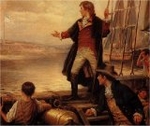
Worksheets and No Prep Teaching Resources
Reading Comprehension Worksheets
A New Nation
(1776-1830)

A New Nation
(1776-1830)
 Worksheets and No Prep Teaching Resources Reading Comprehension Worksheets A New Nation (1776-1830) |
 A New Nation (1776-1830) |
| edHelper's suggested reading level: | grades 4 to 6 | |
| Flesch-Kincaid grade level: | 5.36 |
|
Samuel Slater and the Spinning Machine
By Jane Runyon |

|
 1 Take a step back into history. Winter is coming in 1770, and your mother wants to make sure your clothing will keep you warm during the cold months. When you try on your best shirt, you find that you have grown right out of it. You must have a new shirt. Where do you go to find it? Do you go to the nearest mall? Do you have a choice of color and style? Of course you don't. Shopping was different in those days.
1 Take a step back into history. Winter is coming in 1770, and your mother wants to make sure your clothing will keep you warm during the cold months. When you try on your best shirt, you find that you have grown right out of it. You must have a new shirt. Where do you go to find it? Do you go to the nearest mall? Do you have a choice of color and style? Of course you don't. Shopping was different in those days. |
Create Weekly Reading Books
Prepare for an entire week at once! |
| Leave your feedback on Samuel Slater and the Spinning Machine (use this link if you found an error in the story) |
 |
A New Nation (1776-1830) |
 |
United States
|
|
|
 | Fifty States Theme Unit |
 |
Document Based Activities |